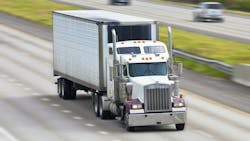Clark: How AI is driving route optimization and efficiency in trucking operations
Key takeaways
- Real-time routing helps fleets avoid delays, cut fuel costs, and improve on-time deliveries.
- AI streamlines warehouse check-ins, reducing bottlenecks and improving operational efficiency.
- Smarter route planning enhances driver satisfaction, retention, and overall fleet performance.
Artificial Intelligence is revolutionizing industries across the board, but few stand to gain as much as the transportation sector. AI is no longer a futuristic concept; it's transforming the transportation industry today.
At a recent NationaLease meeting, Chris Cheetham-West, founder and president of LR Training Solutions, detailed how AI is driving fleets into the future. With the AI transportation market valued at $2.3 billion in 2021 and projected to surge to nearly $14.8 billion by 2030, companies are quickly recognizing that AI isn’t just helpful, it’s essential for long-term success.
Today, 40% of transportation executives plan to adopt AI solutions, and 22% have already begun integrating these technologies into their daily operations. This momentum is being fueled by the need to reduce inefficiencies, enhance customer satisfaction, and address the increasing complexity of modern logistics networks.
AI-powered real-time route optimization reduces delivery delays and improves on-time performance
One of the most promising applications of AI in transportation is route optimization. Traditional GPS systems mainly provide static directions. AI, however, goes beyond by replaying vehicle movements using historical GPS data to identify trends and inefficiencies. It can analyze a range of variables, including traffic flow, weather conditions, road construction, and even events like parades or accidents that may cause disruptions.
For example, if a highway is suddenly closed because of an accident or weather-related issue, an AI system can instantly reroute vehicles using real-time data. This minimizes delays and ensures that deliveries still arrive on schedule. In addition, AI can anticipate peak travel periods and suggest changes to routes or delivery times, helping companies avoid gridlock, reduce fuel costs, and stay competitive in tight delivery windows.
These capabilities are especially crucial in an era when customer expectations are higher than ever. People and businesses now demand accurate delivery times and real-time updates. AI makes this level of service possible while also reducing stress on dispatchers and drivers, who no longer need to manually adjust routes under pressure.
Another area where AI is streamlining operations is at the warehouse gate. By using AI-powered systems to verify truck and driver credentials before they even reach the loading dock, companies can speed up check-in processes and reduce bottlenecks. This translates to faster turnaround times, better use of dock space, and smoother communication between drivers and warehouse staff.
AI-enhanced routing and scheduling boost driver satisfaction and retention
Driver experience and satisfaction also stand to benefit significantly from AI adoption. With the ongoing shortage of qualified drivers, retention has become a top priority across the industry. AI makes drivers' jobs easier and safer by eliminating the guesswork in navigation and reducing the number of unexpected route changes. This leads to less stress, more predictable schedules, and overall higher morale.
At its core, AI in transportation isn’t about replacing human expertise; it’s about augmenting it. By providing better insights, AI empowers teams to make smarter decisions, respond faster to challenges, and operate more efficiently.
As AI continues to evolve, companies that embrace it today will be the ones leading the charge tomorrow. In a fast-moving industry like ours, that edge can make all the difference.
About the Author
Jane Clark
Senior VP of Operations
Jane Clark is the senior vice president of operations for NationaLease. Prior to joining NationaLease, Jane served as the area vice president for Randstad, one of the nation’s largest recruitment agencies, and before that, she served in management posts with QPS Companies, Pro Staff, and Manpower, Inc.


